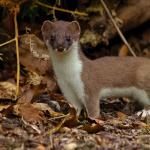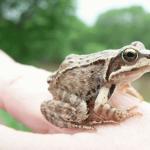The stoat is a predatory animal of the Mustelidae family. A small and very fast animal. An agile hunter who can dance and moves with the speed of the wind. In this article you will find a description and photo of an ermine and learn a lot of unexpected and interesting things about this crafty predator.
The ermine looks very small. However, despite its small size, it is a predator. The animal has a long body and short legs. The ermine's head has a triangular shape and small rounded ears, as well as an elongated neck. The length of the body is about 30 cm. The length of the tail varies up to 12 cm. The maximum weight of an ermine is 260 g. Males are twice as large as females.

Depending on the time of year, the ermine looks different, because the ermine changes color. The winter stoat turns completely white. At the same time, in winter the ermine looks fluffier because the fur becomes soft and thick. In summer, the ermine has a two-color color. The upper part of the body is reddish-brown, the lower part is yellowish-white, and the ermine’s fur becomes coarse and sparse. Only the tip of the animal’s tail remains black all year round.

The winter color of the ermine is predominantly characteristic of the northern regions. The animal sheds in spring and autumn. In spring, the head sheds first, then the back, and then the belly. In autumn, molting begins in the reverse order. In animals that live in the southern regions, the color of their coat does not change in winter. It’s just that in winter their fur becomes thicker.

Externally, the ermine looks very similar to a weasel. But unlike the weasel, the ermine is larger and has a black tail tip. Another difference between an ermine and a weasel is the value of its fur, the length of its tail, and its food preferences. The ermine is a valuable fur-bearing animal of the Mustelidae family with a longer tail and hunts larger prey than the weasel.
Where does the ermine live and how does it live?
The stoat lives in North America, Europe and Asia. It is found everywhere, from the shores of the Arctic Ocean to the southern seas, from the Baltic states to Sakhalin. The ermine lives in the forest-steppe, river valleys, fields, tundra and taiga. It was introduced to New Zealand to control the rabbit population, but was very unsuccessful. The stoat has rapidly multiplied and turned into a pest, destroying the young and eggs of native birds, especially the kiwi bird.

The stoat lives where there is a large population of rodents. The animal also loves water. Therefore, the ermine often lives near reservoirs, lakes, coastal meadows and streams. You won’t find the animal in the thicket of the forest; it prefers edges, beams, and ravines to live. Sometimes the ermine lives next to humans, in gardens, parks, and on city outskirts.

The small predator leads a predominantly solitary lifestyle. It has its own territory, the boundaries of which are marked. The size of such a plot varies from 10 to 20 hectares. Males have a territory twice as large as that of females. The animals live separately and intersect only during the mating season. Exceptions include mothers with litters. In years when there is little food, stoats move considerable distances, leaving their areas.

The ermine is active mainly at dusk and at night, sometimes found during the day. The predator is unpretentious in its choice of shelters. It can be found in the most unexpected places - for example, in a haystack, a pile of stones or an old stump. May occupy tree hollows. Quite often, the stoat occupies the burrows of rodents it has killed. The stoat does not dig its own burrows. In winter, it has no permanent shelter and uses available shelters - under fallen trees, stones or tree roots.

The ermine is a very playful and nimble animal; it is very fast. The animal swims well, dives and easily climbs trees. Often sits out on a tree in case of danger or threat of enemy attack. Usually the ermine lives quietly and silently, but when excited it chirps loudly, hisses and chirps.

The predatory stoat is very brave and bloodthirsty. In a hopeless situation, he risks throwing himself even at a person. The natural enemies of the ermine are fox, sable, badger, marten, and large birds of prey. An ermine lives from 2 to 6 years. The ermine has another serious enemy - man.
Despite the prevalence of the predator, the number of stoats has fallen due to hunting for it. Fur-bearing animals are exterminated by humans because of the value of their fur. The ermine is also exterminated because of the damage it causes to the farm: the animal destroys chickens and laying eggs. However, the stoat is useful in killing rodents and controlling their population.
What does an ermine eat? Features of ermine hunting.
The ermine seems to be a harmless and cute little animal. But this is a very nimble and voracious predator. The predatory stoat feeds quite variedly. The stoat's main food is rodents. The stoat feeds on voles, rats, hamsters, shrews, and chipmunks. However, the little robber is not averse to eating other food - fish, small birds, lizards, insects. The clever thief also destroys bird nests and eats eggs.

The ermine goes hunting at dusk and hunts all night until dawn. He can be so bold and fearless that he attacks large game - black grouse, wood grouse, hazel grouse, partridge. The ermine also hunts animals that are significantly larger than it in size - hares and rabbits.

Fast and nimble, the ermine runs as if creeping along the ground, diving between snags and foliage. It sweeps by like the wind and it is impossible to guess where exactly the nimble animal will emerge from the grass. And in winter, he easily jumps in the snow without falling into the snowdrifts.

Thanks to its compact size, the predatory stoat can penetrate rodent burrows. Since the female is much smaller than the male, it is much easier for her to do this. Therefore, females are considered more skilled hunters than males. And this method of hunting is characteristic mainly of females.

The average diet of an ermine is 5 voles per day. During the night, in search of food, the predator travels from 3 to 15 km. These animals have well-developed senses, so when hunting they use all of them: good vision, hearing and smell.

It moves through the snow with deft jumps up to half a meter long, pushing off the ground with both hind legs. When a likely victim is identified, the stoat gets as close to it as possible, after which it makes a swift dash, sinking its teeth into the back of the victim’s head and wrapping itself around it. If the prey does not die, several more bites to the neck follow. Thus, the stoat attacks from behind, and the prey is killed by biting the victim in the occipital region.

The ermine is considered a rather dangerous animal. One of the unique features of ermine hunting is the peculiar dance performed by the animal. When dancing, stoats hypnotize and distract their prey, which allows them to get closer to jump. This dance of these pranksters is called the “ermine dance of death.”

The mating season of ermine occurs once a year - from March to June. Females become capable of reproduction at 3 months, and males only at the age of 12 months. The female's pregnancy lasts about 10 months. This duration of ermine pregnancy is due to a unique feature - the embryo develops with a large delay. Therefore, stoat cubs are born only in April-May of the following year.
Before giving birth, the female begins to build a nest for herself, which can be located under rocks or under a fallen tree. An old stump, hollow or rodent burrow can also become a place for breeding offspring. The female lines her brood hole with the skins and hair of killed rodents and dry grass.

On average, 4-9 cubs are born, but the maximum number can be up to 18 individuals. Only the female takes care of newborns. Baby stoats look like worms. Small stoats have a mass of 3-4 g, with a body length of 3-5 cm. Ermine cubs are born blind, without teeth, deaf and covered with sparse white hair. After a week, the tip of the cubs' tail turns black. After 3 weeks, teeth appear. After a month their eyes open, after 40 days they begin to hear.

During the first month, the mother almost never leaves her cubs, because they need her warmth and care. The female feeds the cubs with milk for about 3 months. Baby stoats grow quickly and are very voracious. They emerge from the burrow only in the second month of life. During this period, the mother is rarely in the hole; she actively hunts to feed her children.

Ermine cubs show mobility early, immediately after they open their eyes. During the game, the cubs develop hunting skills: biting and capturing. When the cubs can already eat solid food, the mother stores food in the den. These can be rabbits, hares or ducklings.

If there is more than enough food, then you can not only eat, but also have something to do in your spare time. After all, little stoats love to play. They don't sit still for a second. When there is no playmate nearby, the role of a teddy bear that can be tormented will go to the victim that the mother has stored as food.

By three months of life, the cubs reach the size of adults. In July, they hunt and get food on their own. By the end of summer, the brood disintegrates and each individual begins an independent life.
If you liked this article and you like to read about various animals, subscribe to our website updates to be the first to receive only the latest and most exciting articles.
Instructions
Nowhere in the world are there such numbers of large herbivores as in the African savannah. Huge herds of ungulates - zebras, gazelles, antelopes, buffaloes - constantly wander from place to place “following the rain,” eating and trampling grassy vegetation in huge quantities. A significant number of herbivores and their constant and seasonal migrations contribute to the preservation of the typical “park” appearance of the African savanna.
The largest inhabitant of savannahs is the African elephant. Its height reaches 4 m, and its weight is measured in tens of tons. Being a herbivore, the elephant is perfectly adapted to life in the shroud. The trunk allows it to reach the upper branches of plants that are inaccessible to other herbivores, and acts as a pump during watering and bathing.
Another typical representative of the savannah is the giraffe, the tallest animal on the planet. The giraffe is a herbivorous ungulate found only in Africa. Its height reaches 6 m and weighs almost a ton. Despite its very significant height and weight, the giraffe is capable of speeds of up to 60 km/h. But usually he is leisurely, running only when danger arises.
Black and white rhinoceros are typical representatives of the African savannah. Currently they are quite rare. The number of rhinoceroses has been greatly reduced due to their shooting by poachers.
Herds of herbivores are always accompanied by predators. There are 2 types of lions living here - Barbary and Senegalese. The first is north of the equator, the second is south. Another representative of predators is the cheetah - the fastest animal on the planet. During pursuit, a cheetah can reach speeds of up to 110 km/h. In addition to lions and cheetahs, there are quite a few other predators here - bush cats or servals, hyenas, jackals, hyena dogs.
African savannas are home to many birds. A significant portion of birds are migratory and periodically end up here as a result of their annual migrations. The original representative of the savannah, the African ostrich, is the largest representative of all living birds. The ostrich is a non-flying bird. His height reaches 250 cm and weight 150 kg. When running, it reaches speeds of up to 70 km/h, and is capable of abruptly changing the direction of running without slowing down.
Small birds are numerous - bustards, plovers, larks, hazel grouse, starlings, weavers, turtle doves, pigeons, kingfishers, hornbills, etc. A rain stork nests in the crowns of trees. Quite a lot of birds of prey - buzzard, secretary bird, black-winged kite, buffoon eagle, African kestrel, short-eared owl, five species of vultures that fly from Europe for the winter. There are also scavengers, typical representatives of which are the marabou stork and African vultures. The latter perform the role of orderlies in the shroud, since they feed exclusively on carrion.
Savannahs are home to a variety of animals, both carnivorous and herbivorous, living in groups such as prides, packs or herds, and sometimes trying to survive alone in this harsh world.
Herbivores
The largest representative of herbivores is the African elephant, its weight sometimes exceeds 7.5 tons, and this animal reaches four meters in height. Despite such dimensions, this is an amazingly active animal. If the elephant is the most massive, then the giraffe is the tallest; its height can reach 5.8 meters, and an adult male weighs about 750 kilograms.
The most numerous herbivores on the savannah are antelopes:
Antelope Sable
Wildebeest
Greater Kudu
Bushbuck Antelope
Along with numerous antelopes, zebras have become widespread, also grazing in large herds:
Savannah zebras - Burchellova or plains
Desert zebras
Mountain zebras
Predatory animals
Today, the habitat of these animals is limited to the savannas of East Africa, as well as the southern territories of Ethiopia and Sudan. At the same time, in the expanses of savannahs in reservoirs there are numerous hippopotamuses, both dwarf and ordinary.
The weight of these animals can reach 3.2 tons, and their body length reaches 420 centimeters, with a shoulder height of 165 centimeters. The skin of this animal is without hair and only on the tail and muzzle there is hard hair.
Here are the animals that live in the savannah that belong to the predators:
Leopards
Spotted hyenas
The spotted hyena is the largest representative of this family, its weight reaches 82 kilograms, its body is at least 128 centimeters long, with a tail length of 33 centimeters. Its coarse fur is yellow-gray in color, with numerous round black spots scattered on it.
All animals living in the African savanna are links in the same food chain, at the top of which are large predators.
What animals live in the savannah, you will learn from this article.
What animals live in the savanna?
Savannas are wide open spaces, heavily covered with grass, with occasional trees. They are geographically located in Australia, Africa and South America. There is no summer or winter here, but there are 2 seasons - the dry season and the rainy season. These climatic conditions fully determine the fauna that inhabits the savanna.
Herbivores of the savannah
The largest representative of herbivores is the African elephant. The weight of the animal sometimes exceeds the mark of 7.5 tons, and the height of the elephant reaches 4 m. The tallest savannah animal is the giraffe - the animal's height reaches 5.8 m.
List of savannah herbivores:
* Antelopes of such breeds are Sable, Wildebeest, Greater Kudu, Bushbuck and Impala
* Zebras of such breeds are Burchellova, Mountain and Desert zebras
* Rhinoceroses – white and black
* Wild pigs
* Wild horses
Predatory animals of the savannah
Savannah predators inhabit not only the land, but also water spaces. The most massive predatory animal is the hippopotamus, which reaches 3.2 tons and a body length of about 420 cm. The skin of the hippopotamus does not have hair, only the tail and muzzle have a small layer of hair.
In the savannah you can still find the following predatory animals:
- Cheetahs
- Spotted hyenas
- Lviv
- Leopards
- Jackals
The largest representative of the family of predators is the spotted hyena. Its body weight is 82 kg, body length 128 cm, tail length 33 cm. The hyena's fur is coarse, yellow-gray in color with scattered round black spots.
The ermine is a small fur-bearing animal belonging to the mustelidae family. They appear to be very beautiful and charming creatures, but they have a tough temperament and can be very aggressive. Stoats swim very well and climb all kinds of trees. These animals inhabit mainly swamps, bushes, coastal lowlands and adjacent areas. The body of an ermine is very similar to that of a weasel (also a member of the mustelid family). The only difference is the color of the tip of the tail and the larger size of the weasel.
Ermine: photo. 


 Ermine on the stones.
Ermine on the stones.  Klyuchevskoy Nature Park in Kamchatka: a curious ermine on a rock.
Klyuchevskoy Nature Park in Kamchatka: a curious ermine on a rock.
Stoats are very fast and agile animals.
Stoats were brought to New Zealand in order to control the growth of the local rabbit population, however, they did much more harm than good. The animals caused enormous damage to the population of native birds.
Stoats can travel up to 15 kilometers a day! They can overcome such a distance in exceptional cases - when there is an extreme shortage of food.
It is noteworthy that the ermine is depicted on many coats of arms of the European elite.
Appearance
The ermine is a small animal with a long body and short legs. The animal's neck is long and its ears are round. The head resembles a triangular shape. The male's body is about 16-40 cm in length. Females are generally half as long. The tail occupies approximately 35% of the total body length and its length is about 5-13 cm. The weight of stoats ranges from 70 to 270 grams.
The color of the ermine depends on the time of year: in winter the color is white, and in summer it consists of two colors: brownish-red and yellowish-white. The tip of the tail is black, regardless of the time of year.
 Ermine in winter.
Ermine in winter.  An ermine in winter color, a black spot on the tail is visible.
An ermine in winter color, a black spot on the tail is visible.  Ermine in summer.
Ermine in summer. Where does the ermine live?
Ermine is very widespread on the planet. It lives mainly in the northern hemisphere of the Earth. Found in cold and temperate zones of Eurasia and North America. It is widespread in the Old World, except in Turkey, Macedonia, Greece and Albania. In the Asian part of Eurasia, its distribution reaches Iran, Afghanistan, Mongolia and Northern Japan. In Russia it is usually found in Siberia and the north of the European part.
What does an ermine eat?
It should be noted that the stoat is a predatory animal. Its diet is very varied, but the main part consists of a variety of rodents. These are voles, chipmunks, lemmings, haymakers, etc. Stoats can easily penetrate the holes of their victims, as well as overtake them under the snow. However, the burrows of smaller rodents are inaccessible to them due to their size. Stoats can feed on birds and their eggs, fish and shrews. When food is scarce, they can eat amphibians, insects and lizards. In rare cases, hazel grouse, partridges, rabbits, etc. are eaten. Human reserves can also become a source of food for stoats. When there is enough food, stoats make reserves.
To hunt rabbits, the stoat performs a “dance of death.” The animal performs somersaults and jumps not far from the rabbit, slyly wriggles and at the same time imperceptibly approaches him. When the distance is reduced, the ermine quickly attacks and bites the rabbit on the neck. Moreover, death in a rabbit most likely occurs from shock, since the small fangs of an ermine are not capable of quickly inflicting fatal wounds on a rabbit.
 Stoats are fed by tourists.
Stoats are fed by tourists.  An ermine caught a squirrel.
An ermine caught a squirrel.  An ermine after an unsuccessful attempt to kill a bird.
An ermine after an unsuccessful attempt to kill a bird. Reproduction
Stoats are polygamous creatures (have many partners). Reproduction occurs once a year. Activity in males lasts for several months (3-4), from February to June. Females mature quite quickly - at 1.5-3 months, and males closer to one year.
In females, pregnancy ranges from 9 to 10 months. The number of individuals born ranges from 3 to 20, usually 5-7 babies. Newborns weigh only 3-4 grams. They are born blind and with blocked ear canals. Only the female takes care of feeding and raising the offspring.
The reproduction of stoats is subject to sharp fluctuations. It depends on the amount of food, mainly on the number of rodents.
Population status
The stoat population has recently begun to replenish itself, in part because demand for products from these animals has decreased. Although 10-20 years ago the population was on the verge of extinction.


 Ermine: photo of the face.
Ermine: photo of the face.  Ermine: photo.
Ermine: photo.  Ermine: photo on a stone.
Ermine: photo on a stone.  Ermine: photo of the face.
Ermine: photo of the face. The photo below was included in The Guardian's list of the best wildlife photos of last year.
Ermine in spring, North Yorkshire, England. 




















